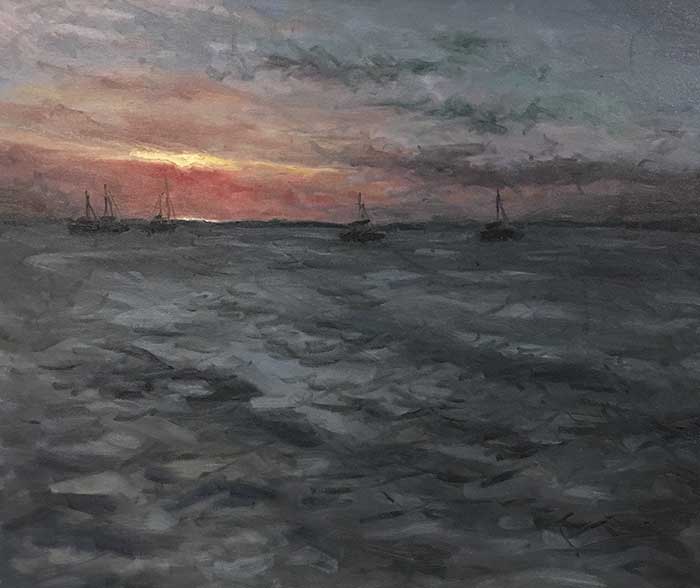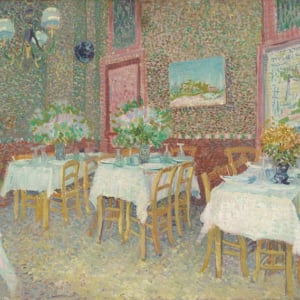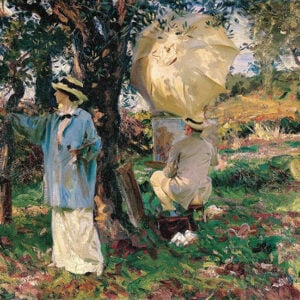Oil paint is inherently slow drying compared to other painting mediums such as acrylic, watercolor or gouache paints. Because of this, you have much more time to manipulate oil paint on your canvas before it dries. This is one of the reasons why oil paint is so widely used by artists.
So how long does oil paint take to dry? The answer is, it depends.
In this post, I will discuss the factors which influence the drying time of oil paint and how you can manipulate the drying time.
- What Factors Influence the Drying Time of Oil Paint?
- The Relationship Between Pigment Color and Drying Time
- The Drying Times of Different Oils
- How to Speed up the Drying Time of Oil Paint
- How to Slow Down the Drying Time of Oil Paint
- Painting Hack: How to Stop Your Oil Paint From Drying on Your Palette Between Sessions
- Additional Readings
- Want to Learn More?
- Thanks for Reading!
What Factors Influence the Drying Time of Oil Paint?
Oil paint does not have a fixed drying time. In general, it dries slower than the other mediums. However, the actual drying time varies depending on:
- The surrounding environment – the local temperature, light, wind, etc.
- The pigment color – some colors dry faster than others.
- The brand of paint.
- The quality of the pigment.
There are many other factors that may influence the drying time of oil paint but these are the main ones.
The Relationship Between Pigment Color and Drying Time

As noted above, the color of the paint can influence the drying time. Here is a summary of fast and slow-drying paint colors:
Fast Drying Colors
- Burnt umber
- Cobalt blue
- Raw sienna
- Burnt sienna
Slow Drying Colors
- Blacks
- Sap green
- Alizarin crimson and most other reds
- Any cadmium colors (cadmium yellow, cadmium red, cadmium orange, etc)
The Drying Times of Different Oils
In oil painting, there are a number of different oil mediums which you can use to give your paint more fluidity. These include linseed oil, poppyseed oil and safflower oil. You can also use an alkyd, which is basically a synthetic oil.
Here is a summary of the different drying times of these oil mediums:
Fastest Drying
- Linseed oil
- Alkyds
Moderate Drying
- Safflower oil
Slowest Drying
- Poppyseed oil
In oil painting, I only use linseed oil however, you may also find poppyseed oil to be useful for keeping your paint brushes wet during painting sessions.
How to Speed up the Drying Time of Oil Paint
You can speed up the drying time of oil paint to some extent by using:
- A paint thinner. I use odorless solvent by Winsor & Newton; or
- Using an alkyd medium. However, I do not have any experience using alkyds nor do I believe they are necessary.
When I start an oil painting, I will usually thin the paint using an odorless solvent so that it becomes a thin wash with a watercolor-like consistency. This layer of paint dries quickly (within 24 hours). After that, I embrace the slow drying time of oil paint, rather than try to avoid it. This process is demonstrated in the painting below.


You could use an alkyd medium to speed up the drying time, but I do not think that is necessary. If you want paint which dries quickly, then use watercolor, gouache or acrylic paint. There is no need to force oil paint to be something it is not. It is much more effective to embrace the qualities of the paint.
How to Slow Down the Drying Time of Oil Paint
You can slow the drying time of oil paint by adding more oil. As discussed earlier, the oil medium you use will influence the drying time. Your paint would dry much slower if you mix it with poppyseed oil compared to the standard linseed oil.
So as a general rule, the more oil that is in your paint, the slower the drying time.
Painting Hack: How to Stop Your Oil Paint From Drying on Your Palette Between Sessions
If I am doing a large-scale painting, then rarely will I be able to finish it in a single session. The painting will often run over numerous days.
A simple way to preserve the paint on your palette between sessions is to wrap the palette in baking paper to stop the paint from drying out. This will only work for one night, but it is effective to some extent. You will notice some drying though.


Additional Readings
Oil Painting – The Ultimate Guide For Beginners
9 Oil Painting Techniques For Beginners
How To Clean Your Oil Paint Brushes
Oil Painting Tips For Beginners
Want to Learn More?
You might be interested in my Painting Academy course. I’ll walk you through the time-tested fundamentals of painting. It’s perfect for absolute beginner to intermediate painters.
Thanks for Reading!
I appreciate you taking the time to read this post and I hope you found it helpful. Feel free to share it with friends.
Happy painting!
Dan Scott

Draw Paint Academy







Thanks for the topic…good example of layering.
Your tips, and I’ve subscribed to/read dozens, are so uniquely powerful and relevant to me. I am truly a failed (trust me, I have a decade of proof)* amateur but I’m a determined one lol. Your shares speak to the many bumps in my road that no book or popular artist has before. There’s a method and list of questions I can ask myself before I just start slapping on paint?!?! Layering is a helpful thing?
Thank you. How you think/teach helps me understand in a new way.
Sharon
*well my work HAS been displayed in a museum. #P.S.190kindergartenpaintingcontestWinner. #5yroldhasgreatfuture
P.S. I just scrolled down and saw a pic of you at an easel. How are you not a seasoned 60yr old? Even more impressed with your abilities.
Haha thanks Sharon. It is comments like that which makes writing these articles well worth it!
Dan
Place your palette in the freezer. Bring out the next day, wait ten or so minutes and you are good to paint.
Thanks for sharing Steve!
Dan
The freezer works great. Give them a minute or two to warm up and they’re good as new.
Hi,
Just saw this thread on keeping your palette wet. I bought a large airtight food container (about 3″ deep), clip-down lid, and had a piece of toughened glass (my new palette) cut to shape (a bit smaller, to be able to pick it out of the container with a fat finger). Put a few drops of CLOVE BUD oil on a cotton swab, drop it in the container, then your wet brushes and wet palette.
I just opened mine after 7 months – still wet and usable paint!! A combination of ideas I saw on YouTube.
Thanks Steve. Great tips, I will have to try this for myself. Thanks, Dan
Regarding storing overnight, i just shove the entire palette in the fridge (4 celsius). Works fine for 2 nights so I can mix evening of day 1, paint on day 2 and day 3 (but paint will get thicker day 3). Works even with very small amounts of paint but important is that you keep the paint in small piles (not smeared out). Using old holland
Great tip thanks! Dan
I have been trying to catch up on your posts. I recently moved and have much work to do in this house. I will have a room I can paint eventually. I’ve enjoyed all you posts that I have read. Thank you
No rush Bonnie. Just read at your own time 🙂 Dan
Danke ! This was what I was looking for and it all depends on the color, and company you are utilizing check me out @punchapproved and my oil painting of Olivia my Ragdoll Blue cat is still drying after a year and it’s about to set! This was a 2 year project so you need a lot of patience working with oil paints
Great read…I use gladwrap over my pallet and put in the fridge can be left several days…someone suggested that to me
Yes, I do the same if I get interrupted,
But has not happened in a long time. Just want to say how fortunate and thankful that I started painting & creating Jan 1st. And I am very happy with doing what I love to do most in live. Art & Making Movies this year is an epic and unique opportunity perfect timing. Check me out @punchapproved On IG .
Life !
Wow ? Having a blast living my best life doing exactly what I love 2 do and that is to paint & create living the dream ! Thanks to a long list of mentors ! Hey I’m finally listening to what you all said and it’s no 1 to be happy ! The way I found a path to happiness is through a medium of Art mostly contemporary but I’m doing every platform it’s a sin not to utilize G-D given talents is a Sin. So go out and create and make something ! Just do something! Believe in you ! As I believe in the power of PUNCH ? and in ART we Trust !
I love this site and these tips! I have a friend who is experienced oil painter and she freezes her paints that she’s using on a styrofoam plate and covers the plate with another plate and tapes them shut with asking tape. She puts them in a gallon size bag and sticks them in freezer. So I did this…then I was not able to get back to my painting for 4 days….I thought they would not be any good, but they are fine! So now I keep a palette of ready made flesh tones on hand in freezer all the time. This also has worked with my acrylic paints too… 🙂
Hi,
first, I’m an engineer, not a chemist. Happy to be corrected. But I looked up the vapour pressure of linseed oil at 20C – it’s zero. So linseed oil paints don’t need to be put in the freezer. They’re not evaporating. They oxidise. So keeping oxygen away is the main thing (which you are doing). I haven’t tested it (I use my own little method, also in this thread) which worked for 7 months. No freezing. I store my palette every session like this. No effort at all. Cheers!
Speaking as a (bio)chemist here: a quick rule of thumb is that chemical reactions slow down 2 fold for each 10C drop in temperature. So at 4oC (20 less than room temp) the oxidizing reaction is 2×2=4 times slower. At -20c the rxn is 2x2x2x2 = 16 times slower. As there are wildly different oil paints out there, everyone might find out what they like best. If you have something to do for the next millennium, you might even try dipping your paint in the liquid nitrogen I’m sure we all have lying around 🙂
I saw this website after I used Oil Paint on my Van Gogh painting and the day after it’s still not dry, My painting is due on Monday and it is Tuesday. Should I just wipe it off or do I wait longer. Every time I touch it goes on my hands and I need it to dry. I can also put it in my cold cellar its cold for the paint or use a blow dryer.
Hi there
I think I made a mistake by adding too many layers and not letting it dry before adding more layers
It’s been 24 hours and my painting is still wet
I have had it in the sun and now have a fan running on it
Any suggestions please?
Kind regards
Lesley
I can attest to the effectiveness of clove oil. It’s a great trick to have up your sleeve when you’re trying to get a likeness on a portrait and it seems like you’ve been shoving that nose or one eye back and forth over the canvas for weeks trying to get it just so, or maybe you want to start a painting but know you’ve got a long vacation/holiday coming up that’s going to land right in the middle of it, it’s great to be able to work a little clove oil into it and know it’ll stay wet for you while you go take a break.
As for the person who thinks they put on too much paint and want it to hurry and dry. I only know two cures. One is scrape it all off and start over, and the other is possess your soul in patience until it dries. Either way, you’re not the first and you’re not alone. Oil paint can take a hell of a lot longer than 24 hours to dry, especially if it’s one with a lot of white in it. Think in terms of weeks not hours.
Hi. Mine is a question. I do block prints, and I want to both slow drying and thin the paint, too. Will I achieve both with the addition of thinner and linseed oil or another oil?
Thanks,
Douglas
Hi Douglas. To be honest, I’m not sure how that would work. I would be careful mixing your paint with too much additional solvent and medium as it will weaken the paint. But give it a go and see what happens. Sorry I can’t be more help!